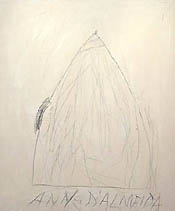
Back: Allan McCollum's Untitled Paper Constructions (1975) and Bruce Nauman's Installation—Wilder Gallery (1973); Front: Tony Delap's Modern Times (1966). Franklin Parrasch Gallery.
The Wilder Bunch
by Ben Davis
"Wilder: A Tribute to the Nicholas Wilder Gallery Los Angeles, 1965-1979," Apr. 22-May 27, 2005, at Franklin Parrasch Gallery and Joan T. Washburn Gallery, 20 W. 57th Street, New York, N.Y. 10019
The Los Angeles art dealer Nicholas Wilder (1937-89) left behind a lot of good will along with a 14-year legacy of pioneering art shows. He opened his gallery in a storefront on La Cienega Boulevard in 1965, a year after Artforum was founded in L.A. and at about the same time that the Los Angeles County Museum of Art hired Maurice Tuchman as its first contemporary curator. Financing for the gallery came from five friends (including Charles Cowles), each of whom put up $2,000, and the artist Barnett Newman, who consigned a major work to the gallery and allowed Wilder to take two years to pay him his share.
| |

Cy Twombly Anne D'Almeida 1967
Joan T. Washburn Gallery
|
Wilder was most famous perhaps for his exhibitions of Bruce Nauman (who is represented in both galleries in the "Wilder" show), but he had a remarkably open mind, showing a total of 71 artists during the lifetime of his gallery. Among the many others who had regular exhibitions there were John Altoon, Allan McCollum, Edward Avedisian, Ron Davis, Sam Francis, Joe Goode, Robert Graham, Tom Holland and Agnes Martin.
In 1979, Wilder closed shop and moved to New York City, where he worked as a private dealer and became a painter in his own right, showing his abstractions at James Corcoran Gallery in Los Angeles and Edward Thorp Gallery in New York. He also became well known for his erudition, amassing a remarkable collection of books that would be bought by the Osaka Art Museum after his death. He passed away in 1989 from complications of HIV.
The current two exhibitions don't dwell on Wilder's personal story, but instead present artworks that he exhibited over the years. Parrasch's space is so packed with good stuff that Walter De Maria's Energy Bar (1967), an ingot at polished steel that is almost hidden, tucked away on a back window ledge. The show gives a good idea of the breadth of Wilder's taste. On the one hand, there is the cool, airbrushed perfection of pieces such as Peter Alexander's pristine Violet Wedge (1969), and Tony Delap's gleaming sculpture Modern Times (1966), a blue aluminum-and-enamel strip folded into a neat arch. On the other, there is the eye-grabbing sexuality of Helmut Newton's Two Women (ca. 1970), a photograph of a nearly nude woman presiding over another who is crouched over a toilet, and Robert Graham's Untitled (Debbie Drake) (1965), a small ceramic and wood box containing two suggestively entwined female figurines. Two early Allan McCollum Untitled Paper Constructions (1975) add a conceptualist element.
| |

George Herms Or how the engineer coming upon the train became ecstatic
1973
Joan T. Washburn Gallery
|
The installation at Joan T. Washburn Gallery features paintings and works on paper. In today's light, the crown jewel is probably the pair of paintings by Cy Twombly, George D'Almeida and Anne D'Almeida (both 1967), large canvases done with house paint, graphite and crayon in Twombly's trademark visceral, jubilant style.
Ironically, the only real sculpture in the Washburn space is also one of the best in "Wilder." George Herms' Or how the engineer coming upon the train became ecstatic (1973) is a compact mixed media work that combines nails, wood blocks and bones in a way that somehow merges deadpan material object-ness with the suggestion of a twisted reference to the body. In some way, the sculpture is a meeting point for the different esthetics that animated Wilder's all-too-brief adventure with art.
An online cataloque of the show, with an essay by art historian Katherine Bishop Crum, can be found at www.franklinparrasch.com
BEN DAVIS is associate editor of Artnet Magazine.
|
